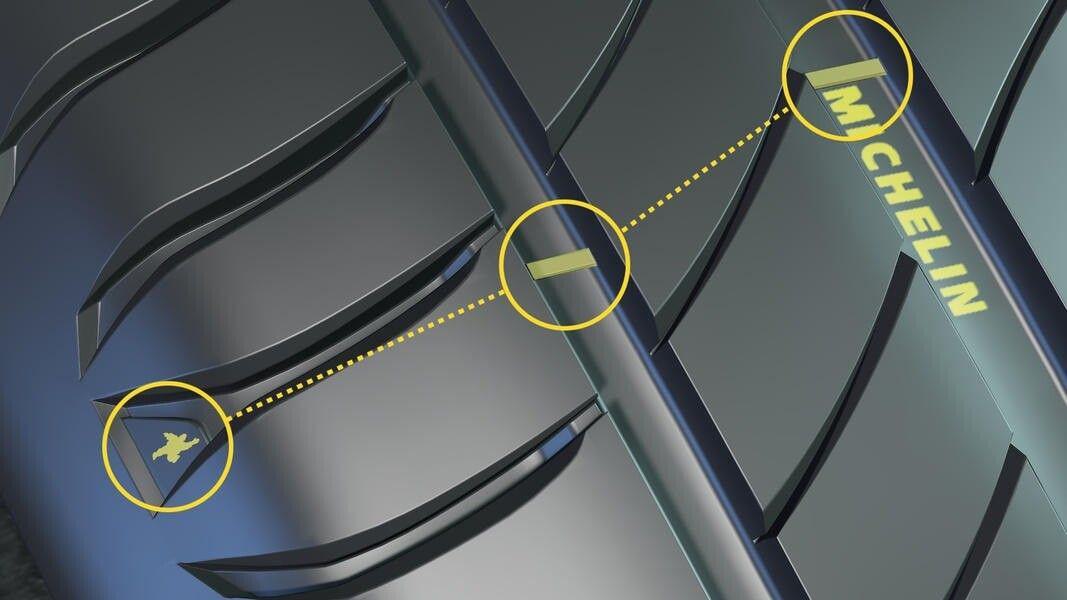- A tread that’s below the legal minimum tyre tread depth (1.6mm for cars)
- Visible tears, cracks or cuts in the sidewall of the tyre
- Stains or discolouration on the tyre
- Unusual bulges, or deformed parts of the sidewall
- Exposed or damaged bead wire
- Separated tread, or split tyre elements
What is a tyre wear indicator?
Tyre wear indicators are marks spaced evenly along the tyre tread, so you’re able to identify how much of the tyre tread depth has worn down. On Michelin’s tyres for passenger cars, a Michelin Man figure is embossed onto the tyres to make it easy to see where the tyre tread depth indicators are. This way, you can quickly identify if the tread is too worn down when checking your tyres.

On Michelin’s latest tyres, you may also find other types of innovative tread wear indicators, such as Wear2Check.
Once the tyre has worn down to the level of the tyre wear indicator, the tread is at the legal tread wear limit of 1.6mm, and must be changed.

How can I check my tyre tread depth using a tyre wear indicator?
Give yourself easy access to your tyres by parking on a flat surface in a wide, open space with limited traffic, such as at home or in a car park. Switch off the engine, and make sure the handbrake is on.
Locate the tire tread wear indicators to know if you have reached the legal limit tread depth. If necessary, use a tread depth gauge to accurately check the current tread depth. This is a simple tool designed to measure car tyre treads. Check in multiple places, all across the tyre, in case of uneven wear.

While you’re at it, you might also want to take the opportunity to look all over the tyres for the signs of wear listed in the checklist above – tyre wear can come in many different forms, including along the middle and in isolated spots.
You should also have your tyres checked regularly by a professional, who can look inside for signs of damage and wear as well as checking the outside.
When should I change my tyres?
Although it may seem like a good idea to change your tyres when they begin to wear down and before reaching the legal limit tread depth, this is costly, unnecessary and can have a negative impact on the environment. On that matter, Michelin’s keeps innovating to offer tyres that can be safely used for as long as possible, until the legal tread wear limit. Thanks to Michelin’s Performance Made to Last, excellent longevity meets high level of performance, from the first to the last kilometer.
However, once your tyres reach a tread depth of 1.6mm, it’s important to replace them as soon as possible to ensure maximum safety on the roads, as well as remaining law compliant. If you have any concerns about your tyres, or are worried that they are wearing down too quickly, make sure to have them checked over by a professional as soon as possible.
Knowing when to replace your tires | Michelin Garage
What are the risks of driving with shallow tyre tread depth?
Although it's normal for tyre tread to wear down and become shallower over time, checking the depth regularly means you can stay ahead of any potential problems, particularly if you discover your tyres are wearing down irregularly or too rapidly.
If you have too little tread on your tyres, this can make it harder for your tyres to grip the road, and could potentially put you and other motorists at risk. This is particularly problematic in wet weather, when you need to keep as much grip on the road as possible to keep control of the vehicle and minimize the risks of aquaplaning.
As well as making driving more difficult as the car is less able to grip the road, driving with bald tyres, that is with a tread depth below the legal minimum of 1.6mm is illegal, and could incur a fine.
Are there any common causes of early tyre tread wear?
It’s important to remember that there are also different types of tyre tread wear, depending on the cause. Here is an exhaustive overview of common causes and different types of early tyre tread wear :
- Underinflated tyres : creates uneven tread wear on both outside edges of the tyre
- Overinflated tyre : causes early tread wear on the centre of the tyre
- Improper camber setting : make the tire wear on either the inside or outside shoulder of the tread
When this occurs, drive to a garage nearby to seek professional advice.
What can I do to prevent tyre tread wear and prolong the life of my tyres?
As a driver, you actually have quite a lot of control over how quickly your tyres wear down. That’s why it’s important to keep some essential factors in mind when driving to help prolong the life of your tyres for as long as possible.
One of the key elements is ensuring the correct pressure for the load of the car and not going over the maximum load capacity advised by your manufacturer, as this can put unnecessary excessive pressure on your tyres. This information will be available on the valve of your gas tank, on the label in the driver’s door, in your car manual or car manufacturer's guide.
When driving, you should avoid sudden braking or accelerating too quickly, as well as avoiding driving quickly over obstacles that might impact your tyres such as potholes, speed bumps and curbs. Finally, you should regularly check the condition of your car, making sure the tyres are correctly inflated and that the wheels are aligned too.




